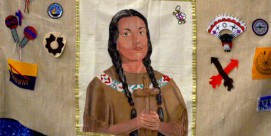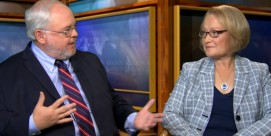In This Episode << SLIDE LEFT TO SEE ADDITIONAL SEGMENTS
Brad Gooch Extended Interview
Read more of the Religion & Ethics NewsWeekly interview with Brad Gooch, author of FLANNERY: A LIFE OF FLANNERY O’CONNOR (Little Brown, 2009):
One thing that [Flannery O’Connor] always does is seems to cross two wires that don’t usually belong together. There’s a story, “A Good Man Is Hard to Find,” about a character called The Misfit, an escaped con who murders an entire family in the woods in Georgia. But this family is a very funny almost kind of ’50s Disney family, so everyone is laughing through the story. At a certain point two people have now been shot, and The Misfit is spouting nihilist existentialist philosophy, and you start thinking, well, this isn’t funny. I can’t laugh at this. So that kind of queasy moment where you’re not sure, when you have two reactions at once, seems very Flannery O’Connor. She’s done a lot with extreme religious figures and backwoods prophets, and there’s almost an apocalyptic mood and violence to these stories mixed with comedy, and I think that this seems very current, like out of the 24/7 news cycles.
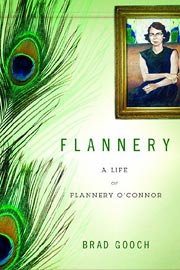 Usually people don’t realize that she’s Catholic. That’s the first reaction. Conan O’Brien wrote his senior essay at Harvard on Flannery O’Connor, and he was being interviewed about it once, and he mentioned that you read these stories and you think they’re by this bitter, drunken old alcoholic guy in Georgia, and then it turns out they’re actually written by this pious woman living with her mother. One way to read these stories is to not get the Catholicism at all. There are only two walk-ons by Catholic priests in these stories. Her real subjects are these kind of Protestant backwoods characters that she saw around her, although she also wanted to then explain that part of her work a lot, so when she started giving lectures and started writing essays, she set out to emphasize or try to frame her own work that way.
Usually people don’t realize that she’s Catholic. That’s the first reaction. Conan O’Brien wrote his senior essay at Harvard on Flannery O’Connor, and he was being interviewed about it once, and he mentioned that you read these stories and you think they’re by this bitter, drunken old alcoholic guy in Georgia, and then it turns out they’re actually written by this pious woman living with her mother. One way to read these stories is to not get the Catholicism at all. There are only two walk-ons by Catholic priests in these stories. Her real subjects are these kind of Protestant backwoods characters that she saw around her, although she also wanted to then explain that part of her work a lot, so when she started giving lectures and started writing essays, she set out to emphasize or try to frame her own work that way.
I think that she purposefully, almost cannily found a way to make stories that were about God in some way. She started a correspondence with a woman named Betty Hester just because Betty Hester wrote her letters saying these stories were really about God. No one had said that before. But she—unlike, say, a Catholic writer who’s writing about parish life—found a way to make these stories that were entertaining to everyone and yet almost writing on different levels, and if you put it on the stained-glass glasses you could see the whole Catholicism in them.
Her father died of lupus, which she developed later in life herself when she was 15 years old, and there’s one kind of unpublished journal that she kept where you see it’s this teenage Mary Flannery O’Connor writing about the death of her father, and she said that the consciousness of God came upon us like a bullet in the side. It’s very interesting. So she already, as a teenager, made a connection between grace and violence, really, so in a sense, it’s this kind of rattling experience that always brings out the grace in her stories, and I think she had these kind of rattling experiences in being faced with death in her own life that made her connect these two.
Her whole view was almost satiric of modern secular culture, and that basically people weren’t at all tuned in to these issues of grace and the meaning of life, and so she felt that her explanation of these extreme, violent characters was that they would shock people and that you needed to shock people at this point to get their attention.
In some ways O’Connor’s also making fun of herself often. The character Joy-Hulga in the story “Good Country People,” who’s this 30–year-old lady with a PhD or something who’s reading Heidegger on this farm with her mother and has a wooden leg, so in many ways a mirror image of herself, and of course she’s always making fun of that kind of intellectual pretension and the college girl and the over-intellectual woman, and there’s some of O’Connor always in that, so she’s making fun of people and she’s puncturing everyone, but finally you feel, thankfully, that it’s also herself that she’s making fun of.
She grew up in Savannah’s Irish Catholic community, but this was very much a subset of a subset in the South. Especially at a certain point, when they moved to Milledgeville in the middle of Georgia, Catholics were very rare. It was the Protestant South. And so early on she was almost figuring she was an outsider, figuring out how to get over to people, and certainly humor worked for her. She taught a chicken to walk backwards when she was a little girl. She walked chickens dressed in bowties down the streets in Milledgeville on a leash. So early on she was trying to bridge this, in a way, and I think that in her work there she went for very startling and extreme kinds of characters to get across in that way.
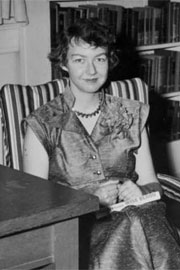 Incomprehension was this joke to her. She almost took pleasure in it. In a certain sense she needed to be misunderstood by this culture for all of her arguments and criticisms to make sense. She also said at a certain point that she would give up 100 readers in the present for one reader in 100 years. So this is also someone who is trying to get across to the ages and to posterity, so she had a very weirdly confident sense of her own talent and genius, too.
Incomprehension was this joke to her. She almost took pleasure in it. In a certain sense she needed to be misunderstood by this culture for all of her arguments and criticisms to make sense. She also said at a certain point that she would give up 100 readers in the present for one reader in 100 years. So this is also someone who is trying to get across to the ages and to posterity, so she had a very weirdly confident sense of her own talent and genius, too.
She used [the word “mystery”] sometimes when talking about her lupus, and I think that this kind of autoimmune disease that would come and rise and fall and no one ever understood exactly what it was, meant that she was living with a kind of mystery about her own mortality. But she also came then to see religion as mystery. Her understanding of God and the world had to do with mystery, and then fiction was a way of delving into mystery. So instead of trying to explain things she would write a story, and so she sort of felt that fiction, because it was capturing this world that she was so good at recording almost by the way that things looked and the comedy of people’s speech patterns, somehow that full view of the world gave people more of a sense of recognition, I think.
The way mystery practically worked out in her stories was that she wrote every morning for three hours, invariably seven days a week, and that she never knew where a story was going. A friend of hers, Robie Macauley, said that she was a demon rewriter, and this was because she kept sort of working through material and then she would hit a dead end and then she would go in another direction or she would reuse something in a novel later. I think that’s a very particular way of working, almost poetic way of working on a story. She even said in “Good Country People” that the reason the reader gets a shock at the end when the Bible salesman steals the wooden leg of Joy-Hulga in the hayloft is because she didn’t know that that was going to happen until about five lines before she wrote it. Because the writer got a shock the reader gets a shock, and I think that becomes part of her way of exploring mystery through the imagination.
What she meant by manners was just the way people behave. I mean she spent most of her time observing, so she was extremely quiet. She had lunch every day with her mother in a restaurant in Milledgeville, and her mother would sit out and talk to people. Flannery would say nothing, but she would listen. She would sometimes get her mother to start conversations at the gas station with the attendant, so she had a great ear for the way people spoke. She was also a painter. Everyone doesn’t realize that, and she would spend time painting the farm also as a way to learn to look. So I think in that way she was recording what people do in this kind of manners and etiquette of life, and somehow the more she did these kind of caricatures the more it also points to what’s behind them.
I think she was very true to her material in having these highly functioning eyes and ears, and at the same time always would give a sense of something breaking through, and it always does. This annoying grandmother character who says she wanted to wear a hat and white gloves on the family vacation so if there was an accident and anyone found her on the road they would know that she was a lady, so that’s the ultimate send-up of manners in a way. And yet the grandmother at a certain point, when faced with the rifle, finally sees The Misfit is her own son and sort of breaks through that, so I think that kind of tension is key to O’Connor’s work.
She got in trouble early on at the Iowa writer’s school for the use of the N word in stories, and this has kind of shadowed her career always in a sense. But her point at that time was that she couldn’t change that word because that’s the way those people speak. So partly it’s staying true. In a way, what we would almost call unpolitically correct at the moment is where she would almost put on blinders and just went for what was really there and worried about reaction later.
There’s some “South Park” in Flannery O’Connor, but she made fun of everything. She was an equal-opportunity satirist in that way, but I do think satirists are often utopian in a way, like Waugh and Swift, and she had some of that, that Catholic sensibility of a perfect world and a heaven and things only made the comedy and the violence and the grotesque more obvious.
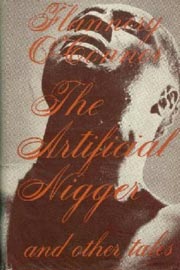 She was very aware of Southern issues. In another way she would also say, when people tried to label her as a Southern writer, well, the South is really just an accent, and I think that’s true. She’s obviously a universal writer. You don’t say that Chekhov is only for Russians—and O’Connor has that, but you know it’s definitely set in a place and she was a great proponent of that, the local, the regional, that a writer works from the world that’s around them. Partly, I think, again, it was her making the best of her situation. I mean, she did seem to be planning on a life in the north. She’d gone to Yaddo, she lived a little bit in Manhattan, she was at the Iowa writer’s school. She was really forced home because of her disease, but there she found her material, really, so it was this kind of prodigal daughter story. She found this great gift by coming home, and she certainly became its great hero and proponent from that point on.
She was very aware of Southern issues. In another way she would also say, when people tried to label her as a Southern writer, well, the South is really just an accent, and I think that’s true. She’s obviously a universal writer. You don’t say that Chekhov is only for Russians—and O’Connor has that, but you know it’s definitely set in a place and she was a great proponent of that, the local, the regional, that a writer works from the world that’s around them. Partly, I think, again, it was her making the best of her situation. I mean, she did seem to be planning on a life in the north. She’d gone to Yaddo, she lived a little bit in Manhattan, she was at the Iowa writer’s school. She was really forced home because of her disease, but there she found her material, really, so it was this kind of prodigal daughter story. She found this great gift by coming home, and she certainly became its great hero and proponent from that point on.
My intuition is that she found her material by being forced home, and when she went to live on the dairy farm with her mother in the middle of Georgia, in those first six months she wrote three stories—“The River,” “The Life You Save May be Your Own,” and “A Good Man is Hard to Find” that are the three kind of classic, trademark, signature Flannery O’Connor stories, so she obviously looked around her and suddenly found all these people no one was writing about, and that she had a great talent to write about them and realized that, and so that would not have happened, and so the idea of her being another southern writer living in New York City—I don’t know what she would have done, but certainly none of these great stories that we think of as O’Connor would be possible.
Surprisingly, O’Connor was writing about black characters in high school in stories and fiction, which no young southern lady did. She said that she became an integrationist when she was taking the bus to Atlanta to go to the Iowa writer’s school in 1946. She then had a black woman friend in graduate school, and her mother told her that wasn’t appropriate, and she refused to go along for that. She voted for Adlai Stevenson and for John F Kennedy, who in the south then were very much associated with integration. But what happened then in the late ’50s and the early ’60s when the civil rights movement became politically correct in a sense and you had people coming from the north to the south, then she sort of went in reverse and at first she didn’t like the idea of people from the north coming and preaching to the people of the south about what to do. Now obviously these are all excuses—Faulkner said the same thing—to slow things down, in retrospect, but she didn’t like a kind of sanctimony about the movement, and so she started making fun of it, and there are unpublished letters to a friend where she then became a connoisseur of these race jokes which sound horrible when you read them now, and she’s like challenging her own redneck characters sometimes, and you can’t tell like where’s the real Flannery O’Connor, and certainly there’s not great empathy there. But it’s complex.
I think the person who described her as a cultural racist was a Trappist monk who’s still in a monastery in Georgia that she used to visit, and he said there was no doubt that—I mean O’Connor never questioned that all, even black people and all races, had shared the blood of Christ in that way, he said. But she could also channel this southern attitude, half herself, half in making fun of it, and so that’s, I think, what he meant by cultural racism. Robert Giroux, her publisher, said to me that Flannery was too intelligent to be racist, and there is an aspect to that. I mean it wasn’t pure prejudice, but in another way she was a little too finely protective of her material and her culture.
She was a great reader of theology. One of the surprises to me was when I went to Milledgeville and saw her library was vast. It’s probably one of the more important collections of 20th-century theology in America, so she loved reading theology. She used to read Thomas Aquinas for 15 minutes before she went to bed. She ssaid reading theology made her fiction bolder. She also became the reviewer for the Atlanta diocese magazine, and she would review a lot of works of theology. I think it was partly to get free copies of all the books. But she was annoyed that the Protestant theologians were a lot more interesting. She had to go back to Aquinas and she wanted a Catholic theologian. I think part of Teilhard to her—and she said literally he was the new Thomas Aquinas for the 20th century, so she was almost looking for him, and she was attracted to this cosmic vision that he had. She was attracted to his language. It was very poetic and almost an unlikely pairing, because Teilhard was then accused of heresy because there was no place for sin in his work, but O’Connor’s stories are all about sin.
 Since he was a paleontologist and he worked with discovering the Peking Man in China, basically Darwinian evolution was also spiritual and that the people are moving eventually towards creating the body of Christ through television and media and all of these ways that they are becoming connected, so a very visionary, poetic view, and that had some kind of appeal for her. Finally, of course, all of this became practical in the craft of fiction for O’Connor. She wrote a story, “Everything that Rises Must Converge,” which is a phrase taken out of Teilhard, so there were certain ways in which it comes into her work in that sense, I think.
Since he was a paleontologist and he worked with discovering the Peking Man in China, basically Darwinian evolution was also spiritual and that the people are moving eventually towards creating the body of Christ through television and media and all of these ways that they are becoming connected, so a very visionary, poetic view, and that had some kind of appeal for her. Finally, of course, all of this became practical in the craft of fiction for O’Connor. She wrote a story, “Everything that Rises Must Converge,” which is a phrase taken out of Teilhard, so there were certain ways in which it comes into her work in that sense, I think.
She’s always trying to say four things in one sentence. When O’Connor went to Iowa City she was actually disturbed at first, she was writing these early stories of “Wise Blood,” the beginning of the novel “Wise Blood,” which opens with Hazel Motes seeing the number for a house of prostitution on the men’s room wall and going off and spending a night with the madam while leaving his tall preacher’s hat on the bed, this kind of comic scene. But she was worried a little how this Catholic girl could be writing such fiction, and she went to see the local priest, and the local priest said to her you don’t need to write for 15-year-old girls. So we can be thankful for that, but then she developed and needed even more of a kind of theological underpinning for this, and she found it in Jacques Maritain, who was doing translations of Thomas Aquinas at the time. These translations were very important for a lot of intellectual conversions at that moment in the late ’40s of people who were friends or acquaintances of hers, Thomas Merton, Robert Lowell, Allen Tate, Carolyn Gordon. O’Connor herself, though, was a cradle Catholic. Aquinas had this idea that an artist wasn’t a moral function like being a priest, that it was a creative function or a craft function, so for the artist, the way in which they showed devotion was by writing the best possible story, and this kind of freed her up. She said good news, you don’t have to be a good person to be a good writer, and in a way that’s what she’s saying, that she has this gift and that therefore following through on this gift becomes an act of devotion. These kinds of comments get people to laugh and are pretty folksy, but O’Connor has another reverberation going on in her own head, and writing her biography you start getting more aware of those reverberations.
[O’Connor and Merton] knew each other by proxy. They were both published by Robert Giroux. O’Connor was first brought into Giroux’s office by Robert Lowell, and Giroux told me, actually, that he knew right then he wanted to sign her up, and he knew that she would be a great writer. I said, well, did you read anything that she had written? And he said no, I could just tell from her demeanor that she would do whatever it took—interesting publishing intuition, but he just published “The Seven Storey Mountain,” and this was a big bestselling book at the time, so O’Connor asked for a copy of “The Seven Storey Mountain,” and then Giroux would go visit his writers at certain times, and he went first to see Thomas Merton who was in Gethsemani, and then Merton, who was an admirer of O’Connor’s, gave a book to go to her, and then she, I think, sent him a peacock feather at a certain point, so they had that sort of back and forth. They were very interested in each other. When O’Connor died, Merton wrote very high praise about how when you think of O’Connor you don’t think of Faulkner or Katherine Ann Porter, you think of Sophocles. I don’t know how much it was in reverse, with O’Connor’s enthusiasm for Teilhard. She never quite went around recommending Thomas Merton to people. I mentioned that to Robert Giroux ,and he thought that was interesting and hadn’t thought of it, but there is some truth there. Merton was an early kind of political left sort of thinker and definitely ahead of her curve on some of that, although she also at the same time he was starting to translate the desert fathers, she was working on a third novel that is unfinished, which relied a lot on the desert fathers, so she seemed to be like Merton, moving towards a kind of more global Vatican II view of Catholicism.
She really liked European Catholic writers, like Francois Mauriac or Waugh or James Joyce. She liked Gogol a lot, which you can see, this sort of exaggerated, grotesque characters. I think she was actually much more influenced by Faulkner than she liked to let on. She had a kind of anxiety of influence going on there with him, so she would say, well, her one-cylinder syntax could never have matched Faulkner, or that when the Dixie Limited is roaring down the track you get your little buggy out of the way, with the Dixie Limited being Faulkner. But, actually, in her library you find that she had every book by him and had read them earlier on than she claimed that she had, so I think he is a kind of big influence.
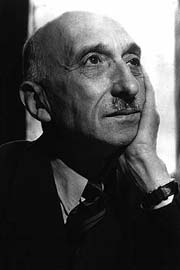 Francois Mauriac |
Actually, one of the few writers that she mentioned was Nathanael West, who wrote “Miss Lonely Hearts,” which is funny, again, offbeat dark humor about an advice columnist who becomes a kind of Christ figure in a certain way. Edgar Allen Poe was a big influence on her, especially early on. She read Edgar Allen Poe when she was 12 and 15 and 17 and you can see later she especially liked the humorous tales of Edgar Allen Poe. There’s one story called “The Man Who Was Used Up,” where a kind of fashionable socialite goes home to his apartment. Someone trails him and looks through the window, and he comes home and sort of takes out his teeth, which are fake, and his eyes, which are fake, and he has a fake arm on and things, and you can see that in “Good Country People” with the unscrewing of the wooden leg, so she liked that kind of grotesque character. More serious later was Nathaniel Hawthorne. She said that she was of the lineage of Nathaniel Hawthorne, you know, the way that he had a kind of dark grotesque that could also have a moral quality to it, so I think “Young Goodman Brown” is an influence on “A Good Man is Hard to Find.” In fact, you can hear Goodman and good man in those titles, and that story about going into the woods and meeting the devil is really what happens in “A Good Man is Hard to Find,” going into the woods and meeting The Misfit. So she had those models. At the same time, she didn’t really like to be called gothic or southern gothic, and she didn’t really like labels at all, so in that way if you called her gothic she’d say she was grotesque; if you said she was grotesque then she’d say she’s gothic. But I think that kind of lineage, this dark comic sensibility she really liked. She was interested in not just Poe but the humorous tales of Poe, so when you get those together you get more of O’Connor than you might get elsewhere.
I think Robert Lowell’s influence on O’Connor is huge, and he became the surprise to me in the book, and a secret hero of it. I actually have my own private theory that I presented lightly in the biography that he was the model for Hazel Motes, because Lowell was going through his conversion, he’d been converted to Catholicism, he was lapsed, and now was on his way back into the church. He was kind of canonizing her, so she became Saint Flannery to him, so he was putting those categories onto her, but at the same time you had someone who was struggling like Hazel Motes, an extreme character, between non-belief and belief, so possibly that way. At the time that she was in Yaddo she had trouble with her publishers. She’d gotten a fellowship to write “Wise Blood” while she was at Iowa, and the publisher didn’t like the first draft and was kind of pushing her towards a more conventional novel and a more commercial novel, and Lowell was kind of bolstering her about going for, I think, the high road of art a little bit more, and also he was the one who really saw in her, almost, his interest in her faith, in religion and Catholicism, partly maybe enhanced her own sense of it, and I think he really encouraged that in her, so they both became kind of interested in medieval saints lives and things like that and spent Christmas Eve listening to Gregorian chant and Mass on records that Lowell had. So I think part of that really encouraged her medievalism. At that point at Yaddo she’d told someone she was a 13th-century Catholic. You can see all of that in “Wise Blood.” And also most practically Lowell introduced her to everyone who became important in her future life and career. He introduced her to Robert Giroux, her publisher, he introduced her to Sally Fitzgerald and her husband Robert Fitzgerald, the poet and translator, and she went to live with them for a year-and-a-half. So I think that he had this galvanizing influence on her, and she did say later in a rare moment in a letter that he was one person she really loved. I asked Robert Giroux if she was in love with him, and he said no, I think she was infatuated with him, and that’s a good kind of answer, but she did tend to like certain men who were larger than life and movie-star handsome in the way that her father had been, and I think Lowell had some of that, and Robie Macauley had some of that in Iowa, but I think it was a marriage of true minds between those two, and he was infatuated with that aspect of her.
Besides the Lowell infatuation I think that there was one person, Eric Langkjaer, who’s still alive, who I spoke with in Copenhagen, who was very helpful, sent me all the letters that O’Connor had written to him. He was a college textbook salesman, he had been to Princeton, he was working for Harcourt, and he was in the south and became introduced by a professor at Georgia College because she was a local author. He became, like Lowell, interested in her mind, I think, and they liked to discuss religion and theology, and she definitely, I would say, had this romantic interest in him, and also he got her off the farm. He would take her for rides, like dates that they went on. One culminated in a kiss, so there was definitely a romantic aspect to this, and Langkjaer then went for the summer to Europe, and there are these letters back and forth, one from O’Connor which she wrote at the bottom, if you were here we would talk for hundreds of hours on the porch, which crosses in the mail with one from him saying that he’s engaged to be married. So that was this crunch moment for her, because it was also the moment when she was moving towards first using a cane, and I think it was almost a last opportunity in that sense. But O’Connor being O’Connor, she got a kind of revenge. She wrote the story “Good Country People,” and the main character is this Bible salesman, and actually Eric Langkjaer, they used to joke and call his catalogue for college textbooks “the Bible,” and so the way in which he seduces almost the invulnerable Joy-Hulga and makes off with her wooden leg becomes a tale of vulnerability and intimacy, so she got revenge. She was never a victim. I mean, that’s the great thing about O’Connor. Sometimes writing about someone who died when she was 39 and seemed to have a constricted life might seem that it would be sad, but it wasn’t, because she was so indomitable in that way and because she had this sense of humor and she would just turn everything around. I could write about her being in the hospital at the end of her life, and she was just so funny about the nurses that there’s always something buoyant there.
 Obviously her illness influenced the writing, and she was very private. She wasn’t comfortable, really, with too much gossip about her. She wasn’t comfortable with photographs of her particularly, but the Flannery O’Connor stories that we know and think of as O’Connor stories she started writing after she returned home to live with her mother, which also meant after she accepted and knew that she had lupus, actually, because for about a year-and-a-half her mother told her that she had rheumatoid arthritis, and she was still thinking about moving back to the north, and she went on a kind of vacation visit with the Fitzgeralds, and Sally Fitzgerald decided to tell her that she didn’t have rheumatoid arthritis, she had lupus, and she said, well, that’s good, I thought I had lupus and I thought I was going crazy. I’d rather be sick than crazy. Classic O’Connor humor at an incredible moment. But she moves home, and Sally Fitzgerald said that she began writing “A Good Man Is Hard to Find” when she herself began to face the other end of a rifle, in a sense. I mean her work becomes not just about the south and these people around her, but also about death, and I think you had to see that that moved her into the zone of writing that she hadn’t been in, and I also think that there’s an aspect there of magical thinking to her writing, that she really somehow felt that writing was keeping her alive. Her father died very quickly of lupus, so her own expectation was that it could be some very quick thing, I mean 6 months. She was actually then one of the early people on cortisone, and that kept her alive for these extra, really, 13 years while also causing her bones to break down, and I think very much that she was staying alive through writing, and you see it at the end of her life, where it becomes a real race with death, and she’s trying to finish this second collection of stories. She’s working on stories she keeps under her pillow in the hospital so the doctor won’t take them away from her. She’s editing one story after she’s had last rites, so all of this seems to me a very clear kind of sense that this is what’s keeping her alive, or why she’s alive. I mean she was definitely a woman on a mission in that sense. There’s a sense of mission behind her work, even if it’s not preachy and moralistic in that way, and I think that that’s all connected with lupus and death.
Obviously her illness influenced the writing, and she was very private. She wasn’t comfortable, really, with too much gossip about her. She wasn’t comfortable with photographs of her particularly, but the Flannery O’Connor stories that we know and think of as O’Connor stories she started writing after she returned home to live with her mother, which also meant after she accepted and knew that she had lupus, actually, because for about a year-and-a-half her mother told her that she had rheumatoid arthritis, and she was still thinking about moving back to the north, and she went on a kind of vacation visit with the Fitzgeralds, and Sally Fitzgerald decided to tell her that she didn’t have rheumatoid arthritis, she had lupus, and she said, well, that’s good, I thought I had lupus and I thought I was going crazy. I’d rather be sick than crazy. Classic O’Connor humor at an incredible moment. But she moves home, and Sally Fitzgerald said that she began writing “A Good Man Is Hard to Find” when she herself began to face the other end of a rifle, in a sense. I mean her work becomes not just about the south and these people around her, but also about death, and I think you had to see that that moved her into the zone of writing that she hadn’t been in, and I also think that there’s an aspect there of magical thinking to her writing, that she really somehow felt that writing was keeping her alive. Her father died very quickly of lupus, so her own expectation was that it could be some very quick thing, I mean 6 months. She was actually then one of the early people on cortisone, and that kept her alive for these extra, really, 13 years while also causing her bones to break down, and I think very much that she was staying alive through writing, and you see it at the end of her life, where it becomes a real race with death, and she’s trying to finish this second collection of stories. She’s working on stories she keeps under her pillow in the hospital so the doctor won’t take them away from her. She’s editing one story after she’s had last rites, so all of this seems to me a very clear kind of sense that this is what’s keeping her alive, or why she’s alive. I mean she was definitely a woman on a mission in that sense. There’s a sense of mission behind her work, even if it’s not preachy and moralistic in that way, and I think that that’s all connected with lupus and death.
O’Connor often has these caricatures of her mother in her stories. In “Greenleaf” Mrs. May is probably the closest to Regina, and she’s gored by a bull in the end of that story. So these mothers who look like Regina often don’t come to happy ends. One of them is shot in the comforts of home. A friend of hers said, “You should be brought up on charges of matricide. What does she think when she reads them?” And O’Connor said, “Oh, she don’t read none of them,” so obviously a testy relationship, and I mean Regina O’Connor was tough. She was running a business on her own. There was something indomitable about her, but what can sometimes be missed is that first of all she was very caring and loving towards her only daughter and was really making this whole environment of this dairy farm possible for her, and they moved there really when O’Connor moved back home so she wouldn’t have to climb stairs, and soon after O’Connor’s death her mother moved back into town. So she basically got a whole dairy farm in operation, providing her daughter with material. I don’t know if she’s thinking of that. Robie Macauley, who was a novelist who knew O’Connor in Iowa, said the sense was that Regina was a tyrant, but a beloved tyrant, so I think you get both in O’Connor, the humor about Regina. At one point [O’Connor] said to Sally Fitzgerald, on a trip to Lourdes, her only trip outside the country she took with her mother, they were riding on a train and she said, “I don’t know what I would do if anything happened to my mother,” so there’s a sense in which she also was dependent on her. They came to some détente. Flannery had her writing time, and that was sacrosanct, at her desk, and the rest of the time she was willing to compromise.
I actually thought of [O’Connor] as reclusive and Emily Dickinson-like. Actually, she turned out to be having this very full life. She wrote letters every day, 3 or 4 letters. If anyone, if a reader wrote to her she would always answer them. During the afternoons, after writing in the mornings, she would have guests come on her back porch and talk to them, and she’d become somewhat of a cult figure, so driving up could be the poet James Dickey or Faulkner’s translator. She also had this, really, madness to explain her work and gave over 60 talks and lectures across America, often on crutches, going to Notre Dame or the University of Chicago or Smith. So all that is pretty active, but interestingly, the work, too, had a lot of life in it. I wrote one other biography, of the poet Frank O’Hara. He described his work as deep gossip, and everyone kind of got that. His poems were about his friends, about art openings, and kind of busy New York cosmopolitan life, but [O’Connor] had a lot of deep gossip in her work also. She would take names from the Milledgeville phonebook, like Tom T. Shiflet. The story “The Displaced Person”—the Guizac family was a displaced Polish family who had come to work on a farm, the Matysiak family who came to work on their farm, and I talked to Al Matysiak, the son, who is still alive and living in Milledgeville and has never read the story. So on the farm that all these stories take place on is a kind of photograph of Andalusia, and besides these inside jokes about her mother and her friends who would show up sometimes as characters in these stories she was also, again, taking on issues of the time, topical issues. She wrote “Everything that Rises Must Converge,” which is this kind of interracial ballet taking place on a newly integrated bus in the south. The year that Martin Luther King gave his “I have a dream” speech, which was televised, she wrote “Revelation,” which has its own kind of trip to the mountaintop visionary ending, although her mountain is purgatory, so she also corrects in a certain way MLK. And religion, big time, she takes on in her work, and the changing south. I mean, she was a writer of the south, but Faulkner was a writer of the Old South. She was maybe the first writer of the New South, which is the Atlanta New South and the south of cars and people actually being displaced from the farms, I think, to the cities, in the way we see Hazel Motes kind of wandering around through half-empty southern towns and abandoned farms.
The letters are interesting. First of all, you get the gossip of daily life. You have thoughts about art, theology, literature. You don’t get confessional presence necessarily, and you don’t ever hear a complaint, and when you then realize what’s going on with her life, medically especially, it’s slightly amazing what she can turn into a joke. She wrote in one of those letters there won’t be any biographies of me for the simple reason that life lived between the house and the chicken yard here doesn’t make exciting copy. But she’s keeping carbon copies of every letter that she’s sent, and when she did go abroad on a trip to Lourdes she wrote up a will and put Robert Fitzgerald in charge of these letters if something were to happen, so I do think that she did see them and was aware somehow that she was putting in these letters also thoughts about art, theology, and things that people would like to read. In fact, her early letters to the woman who is called “A” in that collection we later found out was Betty Hester. Although one woman was living in Atlanta and the other in Milledgeville, 90 miles apart, they didn’t meet, and in a way those letters are almost the most interesting. They’re like the letters to a young poet. O’Connor is using this occasion to explain to this sympathetic reader how she sees literature and theology, and she’s also trying to convert her. At a certain point Betty Hester then becomes Catholic, so it’s a kind of theological version of these letters to a young Catholic a little bit in them. I think [O’Connor] is one of the great apologists for Roman Catholicism in the 20th century, and this is probably because she’s trying to get Betty Hester to see what she sees in Catholicism in those letters.
I went into the project pretty clear-eyed, which was expecting this prickly personality, and I didn’t entirely agree with all of her politics and things, so I didn’t have that biographer’s being in love with your subject and then being let down or disillusioned, and indeed it worked a bit in reverse, so that by the time I finished the biography, especially in writing about those last months of O’Connor’s life, where she’s kind of in a race with death to finish these stories, you just can’t help but so much admire her discipline and courage, that in a way she became a more profound character than I expected, and I became a more sympathetic and empathetic with her life.
If she’s a saint she’s definitely a medieval saint, not a 19th-century saint, because she’s an extreme character and cranky and has a kind of W.C. Fields sensibility about those kinds of things, but one who can speak to us because she’s not saccharine, she’s not moralistic, but she has this kind of consciousness that goes with it that makes her, if anything, a postmodern saint.
O’Connor’s absolutely a great American writer and especially a great American short story writer. Robert Giroux told me that when he got “A Good Man Is Hard to Find” in the mail from her, the first draft, and he took it home with his papers from work and read it that night, he thought this is as great as “Bartleby the Scrivener,” I mean a classic American story. When you read an O’Connor story, it continues to have some powerful effect. It has this kind of tug on your heart. I mean there’s something very grounding about those stories and disturbing about them, so they have powerful effects. I think part of why we’re drawn to them is no one can exactly, finally label what that effect is or solve the riddle of those stories, and her personality—I think that’s why we keep coming back to her. I think people have an expectation sometimes that I’m supposed to explain this story forever, or I’m supposed to explain O’Connor with one kind of psychological key, but she retains mystery herself and retains paradox. But that’s her fascination and the fascination of those stories.
Surprisingly, she never wrote about her Lourdes experience. She was forced into going to Lourdes by her cousin, Katie Seemes, a kind of wealthy older woman who had lived next to the family in Savannah and had decided to put up the money for this trip. Remember O’Connor was now on crutches and had lupus, so there was a cure kind of motivation there, I think. So she went with her mother, and she was resisting it. At the same time there was an obvious kind of fascination that she had. She talked about it with Katherine Ann Porter, and there she was very positive about doing this. Having written this biography, one thing that’s had a big influence on me is this “what would O’Connor think of this?” is constantly with me. You know, I’m like, on unlikely occasions, “what would O’Connor think of Madmen?” In Lourdes she said that she was someone who would rather die for her religion than take a bath for it, which means that she didn’t really want to go into the waters. She did finally and said that she didn’t pray for her bones, she prayed for her novel. She had her own take on this. It is interesting that she didn’t write about it, and it points to that she had a very strong sense of her material and she would write about that, that in a way when she tried to write about other kinds of material, it didn’t really work. People were meant to write about what they were meant to write about, and the Lourdes experience—she wasn’t a memoirist or a particularly confessional writer in that way, but she did come back from that trip and get to work on “The Violent Bear It Away” and had a kind of gust of energy for that, and that’s a novel in which, it just occurred to me now, where there’s this kind of baptism that involves a drowning and things, so the whole fear of getting in the water in that way might have reverberated in that book.
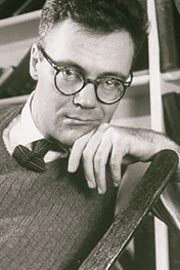 Robert Lowell |
I’m very drawn to the novelistic biography, where you really, like in a 19th century novel, get a sense of someone from birth till death. You keep their pulse alive on every page as much as possible, and you have mixed with this all these facts and all this information that we love. And so in a certain way that allows room for a more complex and mysterious person, and I think that people’s lives are more complex than fiction, so biography is great in trying to reconcile all this. I open with a prologue called “Walking Backward,” and it’s a story, first, of O’Connor at five or six years old trying to teach her chicken to walk backwards and this being filmed by Pathe newsreel company who comes to Savannah to film this. The archive still exists. O’Connor, in a rare essay, “King of the Birds,” wrote about this. It was a rare example of confession and memoir and meditation on herself, and why she’d been so, she called it, marked for life by this experience, partly a joke on her own fame, in a sense. But she did talk about it often. She liked to tell the story of the chicken walking backwards to Robert Lowell and people later on, and I do think, though ,that if I had to pick one kind of trait, the contrariness of O’Connor explains a lot, so in a sense while I was leaving it open to hopefully capture the mystery and complexity of her life, I also started by pointing out contrariness. She was working counter-clockwise to the culture, writing stories with religious messages in a kind of secular culture. The way she lived her life, it was all contrary. When I mentioned race before, that she almost developed backwards, that she was in favor of integration when it was shocking to everyone in town in 1948, and when it became more popular in the early ’60s then she was suddenly against it. So in that way I did have certain interpretations of her that go through, like leitmotifs.
There’s a lot of significance to the peacocks, and it’s become her logo. It’s on the cover of my book. It’s often associated with O’Connor. I do think the key to the peacock is a little bit of the chicken walking backwards. She said it herself: whatever that was all about, actually it led to my peacocks. In her life, when she returned to the south and comes to live with her mother on the dairy farm, two things happen. She starts writing these great stories, and she orders her first peacock, and she’d never actually seen a peacock. By the end of her life she had 39 peacocks, which would, at least twice in the correspondence, they would all open their tails simultaneously, she said. These tails were a map of the universe, so there’s great beauty, and so she was obviously a great pattern-maker in her fiction. The last story that she wrote, “Judgment Day,” was a retelling of the first story, “The Geranium,” that she had published in Iowa. But also in her life she was sending messages and living by design, and so the peacock becomes her self-chosen kind of a symbol, and I think she liked it because it was a comic and gawky bird, like herself. It ate her mother’s flowers and kept everyone awake all night, and then at a certain transfigurative moment tails would open, and here’s all this beauty, which she saw as a symbol of the way her fiction worked, and also in the Middle Ages the peacock was a symbol of Christ in the church, so it all lined up for her in the peacocks.


